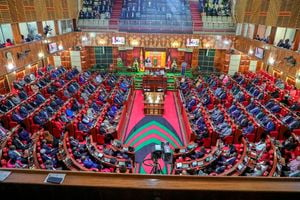Why Kenya’s economy is down on its knees

Former Treasury Cabinet Secretary Henry Rotich arrives at Parliament buildings on June 13, 2019 to read the 2019/2020 Budget. PHOTO | FILE | NATION MEDIA GROUP
What you need to know:
- In the first three quarters of 2019, tea production fell by 9 per cent, coffee sales at the Nairobi coffee exchange by 4 per cent and cane delivery by 11 per cent.
- The country’s top agricultural export earners recorded declining prices over the first three quarters of 2019.
- In 2019, Kenya’s diaspora remittances stood at Sh285.5 billion, up by Sh13.6 billion in 2018, latest data from the World Bank shows.
Unemployment has risen steeply while agricultural exports have dropped, pulling down Kenya’s overall growth projection for 2019 to 5.6 per cent from 6.2 per cent.
Coupled with this is diminishing access to credit for businesses, rising inflation and the taxman’s missed revenue targets, a clear indication that businesses are not generating enough.
Worse still, Kenya is now depending on diaspora remittances as its biggest source of the dollar, joining the likes of Somalia for this line of sustenance.
Parliament, through its budget office and the Budget and Appropriations Committee, is clear that the National Treasury needs to steady the ship or the country heads into a serious meltdown.
ECONOMIC GROWTH
Through the Budget Policy Statement, Treasury Cabinet Secretary Ukur Yatani said the main contributor to the dampened economic growth in 2019 was the agricultural sector’s poor performance due to reduced output and sale of most of the major cash crops.
In the first three quarters of 2019, tea production fell by 9 per cent, coffee sales at the Nairobi coffee exchange by 4 per cent and cane delivery by 11 per cent.
The country’s top agricultural export earners recorded declining prices over the first three quarters of 2019, with the average price per kilogramme of tea and coffee between January and September 2019 being 23 per cent and 29 per cent lower respectively.
Consequently, the value of tea, coffee and horticultural exports declined by 23 per cent, 10 per cent and 9 per cent respectively in the first three quarters.
“We’ve observed that the government's growth projections have been overly optimistic only for them to be revised downwards in the course of the year,” Mr Kimani Ichung’wa, the chairman of Parliament's Budget and Appropriations Committee, said in a report analysing the policy statement that was tabled in the House last Wednesday.
JOB CREATION
The Parliamentary Budget Office, in its report to the committee Mr Ichung’wa chairs, raised concerns on the job creation agenda of the Jubilee government, which has failed since it took over seven years ago.
“This economic growth isn’t broad-based and, therefore, it is not creating enough jobs,” Mr Ichung’wa said. There is concern that the growth benefits are not equitably distributed, giving rise to pockets of poverty and joblessness, he added.
Also alarming is the fact that Kenya has since shifted to depending on diaspora remittances to replace under-performing principal domestic exports such as tea and tourism as the main source of foreign exchange.
In 2019, Kenya’s diaspora remittances stood at Sh285.5 billion, up by Sh13.6 billion in 2018, the latest data from the World Bank shows.
“Exports as a share of the Gross Domestic Product have been on a steady decline in the last decade. Our foreign exchange reserves are now being primarily driven by remittances as opposed to earnings from exports. This poses a risk because of the volatile nature of annual remittance growth,” Mr Ichung’wa said.
FOREIGN RESERVES
Remittances also contributed to the maintenance of foreign reserves at above five months of import cover throughout 2019.
The country also witnessed a rise in food inflation in the last three months of 2019, with the prices of some foodstuffs such as maize and beans increasing.
The saving grace for the economy was the low fuel prices, which negated any further escalations in food and other related costs. The inflation rate rose to 5.8 per cent in January due to the upward trend in both food and fuel inflation over the last quarter of 2019.
Going forward, desert locusts’ impact on agriculture and food production may result in higher inflation rates.
The Kenya Revenue Authority (KRA) has in the last four financial years failed to meet its targets as the economy struggles.
The 2020 budget policy statement has since seen a downward revision of the ordinary revenue target for the 2019/20 financial year by Sh33.4 billion. Tax heads whose projections have been reduced include income tax, import duty and Value Added Tax.
DOWNWARD TREND
Businesses’ access to private credit remains a challenge. As at last November, it was only the insurance, trade and consumer durables sector that had recorded an improvement in accessing credit. Data from Central Bank shows key sectors like manufacturing and agriculture were struggling for credit.
Private sector credit “is expected to expand from the current 7.3 per cent in 2020 due to the repeal of the interest rate cap,” Mr Ichungwa said. Should this happen, it will support higher economic activity for the private sector and boost revenues.
On the money markets, the Nairobi Securities Exchange (NSE 20 share index) has shown a downward trend since 2018. The drop was minimal in 2019.
“The NSE 20 share index declined from 2,797 points in November 2018 to 2,619 points in November 2019,” the budget office said, with the market concentration continuing to be a major risk at the NSE.





